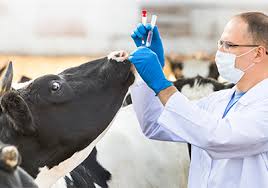Back to: Animal Husbandry SS 3
Welcome to today’s class!!
We are thrilled to have you in our class!!
In today’s Animal Husbandry’s class, we will be learning about Prevention And Control of Farm Animal Diseases.
Prevention And Control of Farm Animal Diseases
In our previous classes, we have established how important it is improve the health of farm animals whether or not we eat them. The exciting part about not having to worry about farm animal diseases is that they can be prevented or controlled.
Let’s take a look at some Farm Diseases and how they can be prevented.
- Anthrax
Anthrax, a highly infectious and fatal disease of cattle, is caused by a relatively large spore-forming rectangular shaped bacteria called Bacillus anthracis. Anthrax causes acute death in ruminants.
The bacteria produce extremely potent toxins which are responsible for the ill effects, causing a high mortality rate. Signs of the illness usually appear 3 to 7 days after the spores are swallowed or inhaled. Once signs begin in animals, they usually die within two days.

Preventive measures:
- Regular annual vaccination of animals in endemic areas will prevent the disease from occurring.
- Vaccination may be carried out at least a month prior to expected disease occurrence in endemic areas.
- Never open a carcass of an animal suspected to have died from anthrax.
Foot And Mouth Disease

The foot-and-mouth disease is a highly communicable disease affecting cloven-footed animals. It is characterized by fever, formation of vesicles and blisters in the mouth, udder, teats and on the skin between the toes and above the hoofs. Animals recovered from the disease present a characteristically rough coat and deformation of the hoof.
Preventive measures
- Heavy milch animals and exotic breeds of cattle bred for milk should be protected regularly.
- It is advisable to carry out two vaccinations at an interval of six months followed by an annual vaccination programme.
- isolation and segregation of sick animals. It should be informed immediately to the veterinary doctor
- disinfection of animal sheds with bleaching powder or phenol
- proper disposal of carcasses
- control of flies
Rabies (Mad Dog Disease)
Rabies is a disease of dogs, foxes, wolves, hyaenas and in some places, it is a disease of bats which feed on blood.

The disease is passed to other animals or to people if they are bitten by an animal with rabies. The germs which cause rabies live in the saliva of the sick (rabid) animal. This is a killer disease but not every dog which bites is infected with rabies.
- Preventive measures
Dogs in the community can be vaccinated against rabies. Farmers should ask veterinary service about vaccination against rabies. If there is an outbreak of rabies, the livestock in the community can be vaccinated too.
In summary, preventing farm animals disease will help improve the overall well-being of farm animals and protect them against parasites and threatening diseases. Remember, prevention is better than cure!
Evaluation
What do you understand by prevention and control of farm animals diseases?
Reading Assignment
Explain the importance of prevention and control of farm animals diseases.
Weekend Assignment
Name three farm animals diseases and their preventive methods.
We hope you enjoyed today’s class. In our next class, we will be learning about Prevention And Control of Livestock Parasites.
Let us know your thoughts and questions in the comment section, and we will attend to them as fast as we can.
